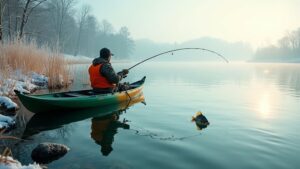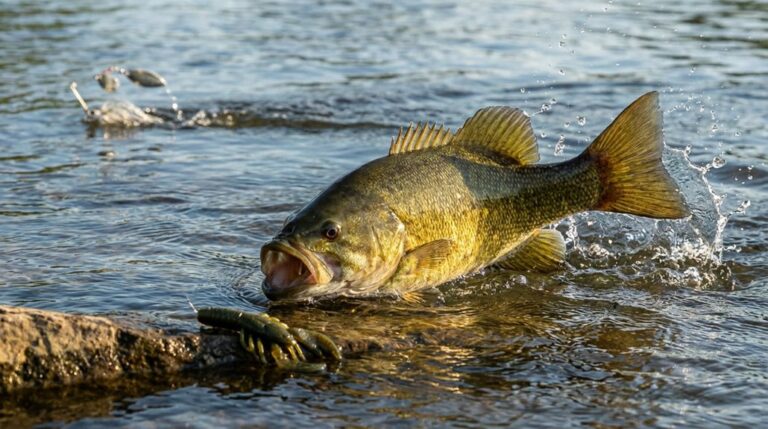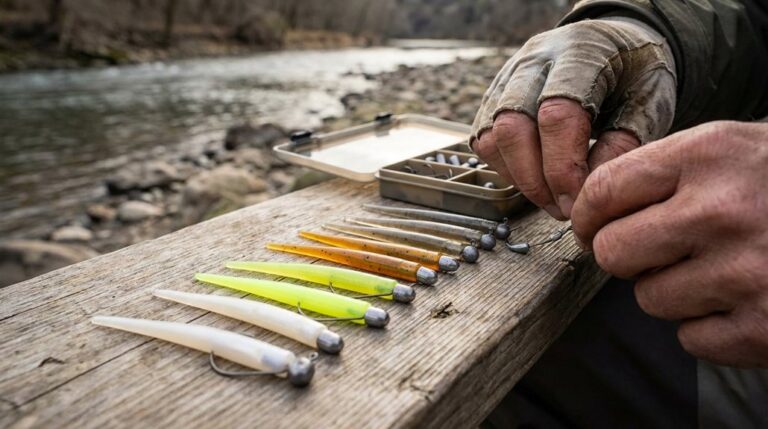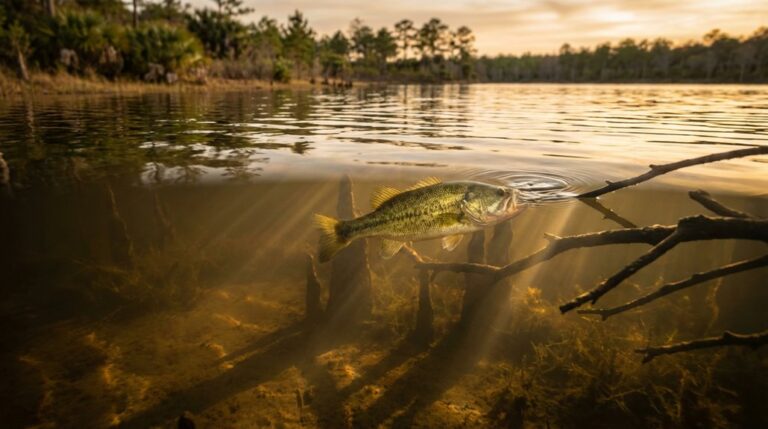You’ll catch more winter bass in clear lakes by hunting bait, not arbitrary depths; start by locating shad schools with forward-facing sonar or surface signs and work points, humps, rock piles and sunken timber that bridge deep basins. Use small, shad-colored baits—jerkbaits, flukes or finesse jigs—on light leaders and slow retrieves with short pauses. Position precisely over bait and repeat productive passes. Keep this approach and you’ll find how gear, electronics and presentation tie it all together.
Important Takeaways
- Locate shad schools with forward-facing sonar and fish directly above or inside those bait concentrations.
- Prioritize offshore structure—rocks, humps, sunken timber, and drop-offs bridging deep basins to bait.
- Use small, shad-colored, slow presentations (jerkbaits, flukes, small jigs) with frequent short pauses.
- Fish light, low-visibility leaders (6–8 lb fluorocarbon) on sensitive rods for precise placement and bite detection.
- Build repeatable search patterns: map likely ambush sites, mark bait/fish, and make focused, accurate casts to structure.
Deep Is Relative: Defining “Deep” for Your Lake
How deep is “deep” on your lake? You’ll learn it’s lake-specific: 15–20 ft might be deep somewhere, while 40–50 ft or more is normal elsewhere. Don’t fixate on a single number — depth for winter bass is governed by bait and underwater habitat, so you’ll find fish holding on structure rather than at arbitrary depths. In clear-water systems you’ll usually locate bait first, then work nearby deeper structure where bass suspend. Focus on rocks, humps, submerged timber, and brush piles that drop to those offshore depths. Mark and revisit known zones at their characteristic depth ranges, and you’ll build a repeatable search pattern that helps you find winter bass across days and changing conditions.
Start With the Bait: Locating Shad Schools and Prey
If you want consistent winter bites on clear lakes, start by finding the shad—bass almost always hang where the forage is concentrated. Use forward-facing sonar or vertical electronics to pick out baitfish columns and rising shad schools at mid to deep depths, then position yourself to work the zone above or inside that bait.
Watch for surface signs — feeding birds, slicks, or boiling water — that point to active shad in the upper column. Focus on mapped high-percentage bait areas like creek channels and submerged timber where shad tend to congregate.
Fish glare-producing, mid-column presentations (jerkbaits, fluke-style jigs) or tuned multi-bait rigs to imitate schooling shad and trigger winter strikes. The right gear choice, like a lightweight, sensitive rod with a high sensitivity to detect subtle bites, helps convert those presentations into hookups.
Reading Structure: Points, Humps, Timber, and Drop-Offs
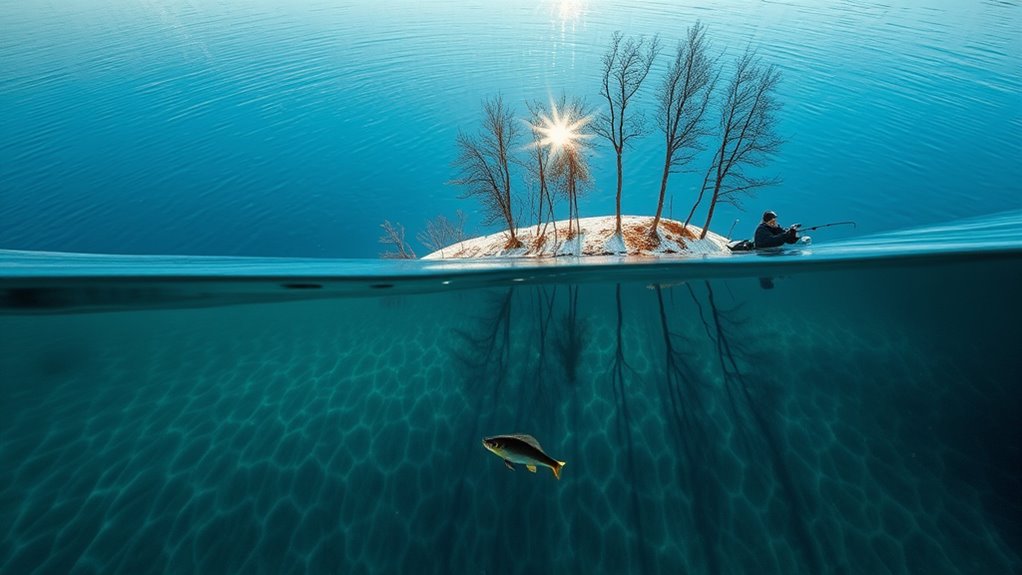
Once you’ve tagged the bait, start reading the structure underneath and around those schools—points, humps, timber pockets and drop-offs tell you exactly where suspended bass will sit in clear winter lakes.
You’ll prioritize offshore structure like points and humps that bridge 30–50+ ft basins to nearby bait concentrations, because those transitions concentrate prey and create predictable ambush lanes.
Use electronics to identify gradual or abrupt depth breaks and mark timber or rock transitions where fish hold just off the edge.
Listen for bait activity around structure; surface or subsurface commotion pinpoints feeding zones.
Combine map study of historic offshore features with on-water scanning to build a network of consistent ambush sites, then target those spots repeatedly.
Many anglers pair that approach with durable, freeze-proof gear like freeze-proof tip-ups to maintain bites in extreme winter conditions.
Electronics That Change the Game: Forward-Facing Sonar Tips
When you swing on forward-facing sonar, you get a live window into how bait and bass are behaving ahead of the boat, letting you instantly adjust depth, lure choice, and retrieve cadence to match what you see.
Use forward-facing sonar to spot bait schools and watch bass reactions in real time so you can immediately tweak pauses, cranks, and speed to trigger follows and bites suspended off deep structure.
Scan ahead for rocks, points, humps, and drop-offs that concentrate winter bass, then mark and prioritize those high-percentage spots.
Verify whether bass are following your lure and note the exact depth of active fish, repeating casts at that depth.
Combine forward-facing sonar with map study to quickly learn daily water-column patterns.
Always prioritize safety on winter outings by confirming ice thickness and carrying personal flotation and ice-rescue gear when operating near or on frozen water.
Spinning Tackle and Line Choices for Clear, Cold Water
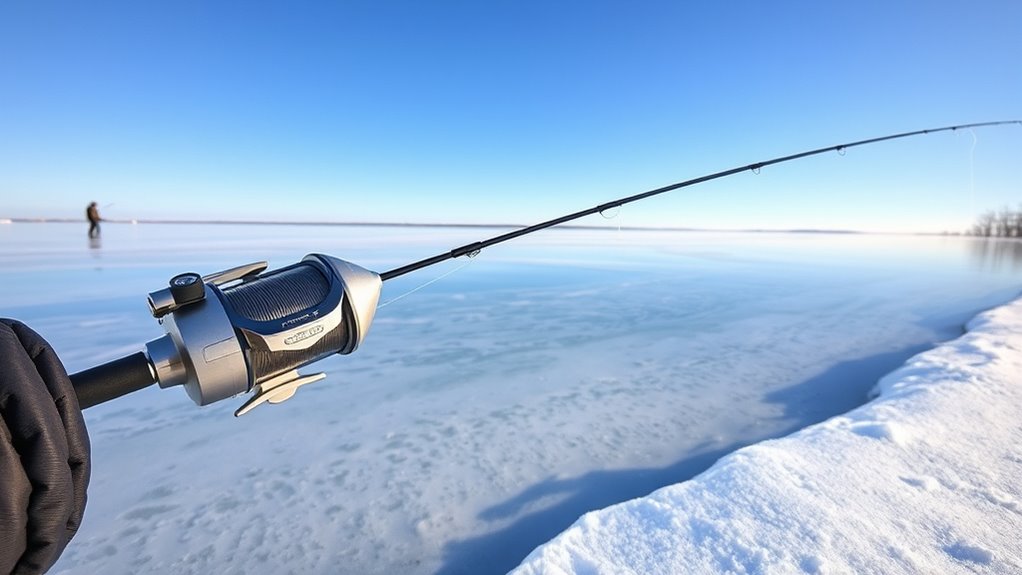
Why choose a longer spinning stick for clear, cold-water bass? You’ll cast farther, control light presentations, and keep lures away from spooky fish with a 7-foot, medium soft-action rod.
Pair that rod with braid for the mainline and a 6–8 lb fluorocarbon leader to cut stretch, boost sensitivity, and stay concealed in shad-clear water.
Use long leaders to avoid knot friction at the reel and reduce line visibility through shallow-to-mid columns.
Pick one versatile rod, a handful of light to medium jigheads, and a tight braid-to-leader knot so you detect subtle winter bites.
For visibility and tracking, run bright green braid when you need to watch line movement, but keep gear simple to fish effectively.
Also remember that seasonal patterns matter—winter fish are often more lethargic, so slow presentations and targeting deeper pools can increase your chances.
Three Proven Baits: Jerkbaits, Alabama Rigs, and Flukes
Curious which baits will actually catch cold, clear-water bass? Jerkbaits shine in those conditions: their flash and pause-driven action mimic fleeing shad, letting you trigger bites from distant fish when you use short twitches and pauses.
Alabama Rigs imitate a small school and work great for suspended or cruising bass; cast them past fishy targets and let multiple swim-tail lures present obvious, shad-like profiles.
Fluke-style baits on a jighead excel for mid-column to deep-water holds—slow retrieves with occasional pauses pull reaction strikes from bass near structure.
In clear water, visibility and shade matter, so choose shad-colored profiles that maintain presence at distance.
Use forward-facing sonar to confirm bait depth and bass responses, then tweak cadence and depth accordingly.
The right gear balance—durable reels with a machined aluminum housing—helps you fish longer and handle bigger winter bass.
Presentation and Retrieve: Sink, Pause, and Adjust
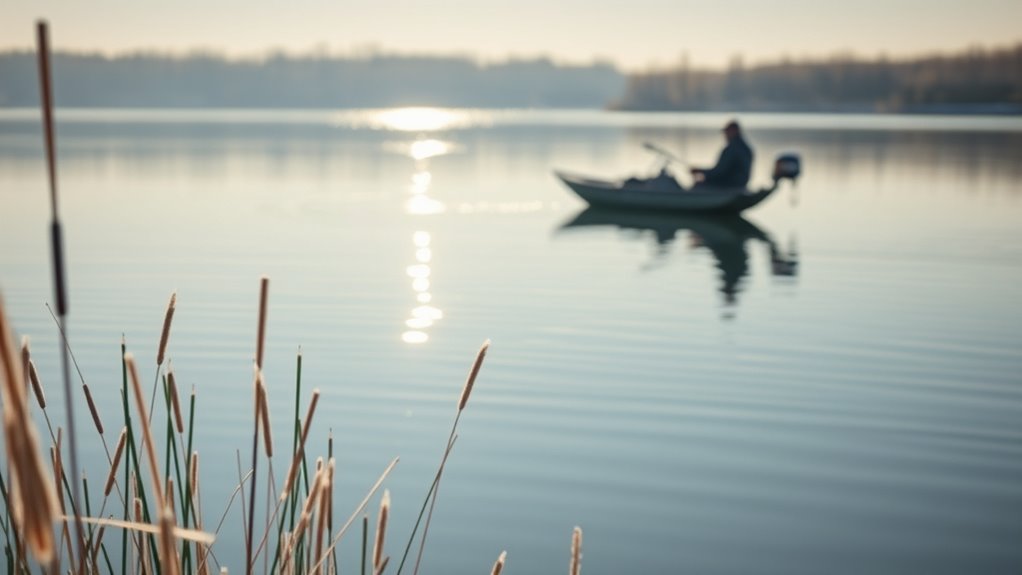
Wondering how to make a cold, clear-water bite? Use a sinking presentation: cast, let the bait drop to the mid or deep column where winter bass suspend, then start a slow retrieve. Watch the rod tip and line for subtle taps and twitches; when you see a twitch, pause briefly to let wary fish commit. Adjust sink time by water clarity and depth so your lure stays in the strike zone.
Keep pauses short and purposeful—usually 1–3 seconds in clear water—then resume with a controlled, slow-to-medium retrieve. Vary speed incrementally and add short pauses when you feel weight shifts. Use LiveScope or forward-facing sonar to confirm lure depth and ensure you’re presenting directly above feeding shad. Consider a multi-piece, lightweight rod for easier travel and more sensitive tip feedback when detecting subtle winter bites, especially with lightweight materials that improve sensitivity.
Efficient Search Patterns and Waypointing on the Map
Ever want to make your time on the water pay off? You’ll start with map study to pick points, submerged islands, creek channels and drains, then prioritize spots with bait and offshore structure. Pre-plan routes that cover typical clear-water winter depths (30–50 ft) and aim to find bait schools first.
- Mark rocks, humps, submerged trees and brush piles to build a network of high-percentage waypoints.
- Plan repeated passes between those waypoints to force reaction strikes.
- Use electronics to confirm bait and fish-holding objects, then drop a waypoint on any confirmed target.
- Update waypoints from bird activity, schooling bait or lure hits to refine future search patterns.
This method keeps your searching efficient and your catch rate higher. Fish often display shoaling behavior in winter, and locating bait schools can be the key to finding bass.
Final Thoughts
You’ve got the tools and tactics to catch bass in clear, cold lakes — now go use them. Start by finding shad and the structure they hug, then choose lures and line that match visibility and depth. Vary your retrieves, pause often, and mark productive spots on your map. Pay attention to electronics and subtle strikes; winter bass are picky but predictable. Stay patient, keep adjusting, and you’ll put more fish in the boat.

